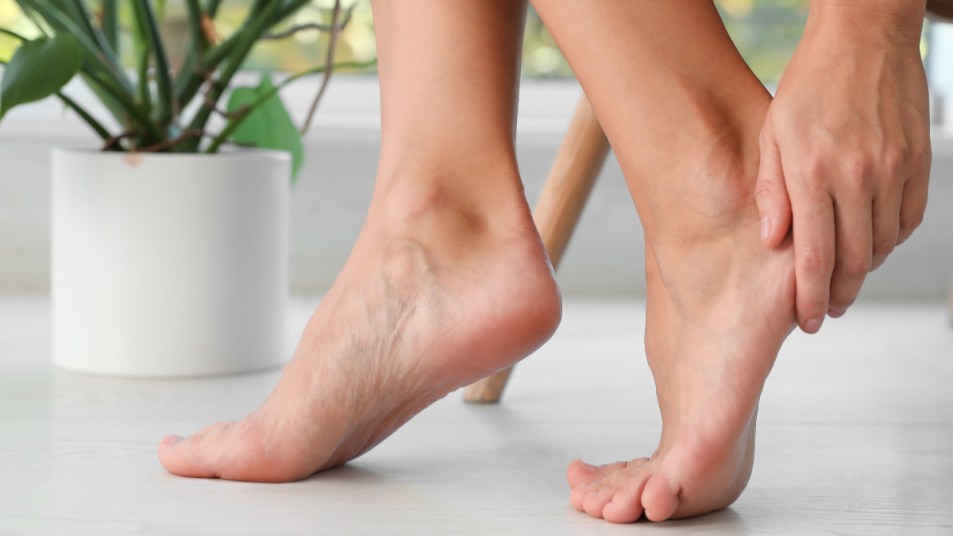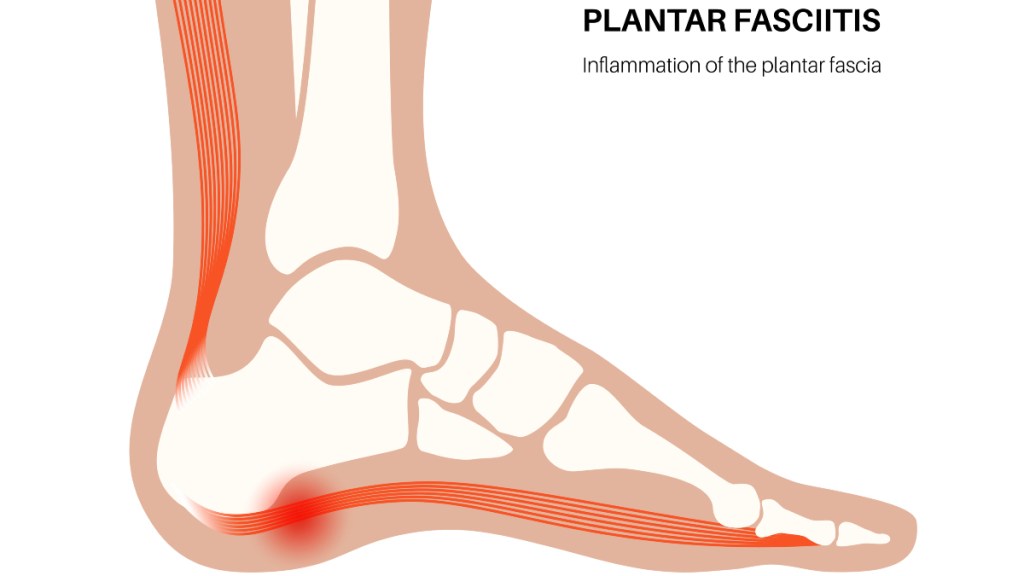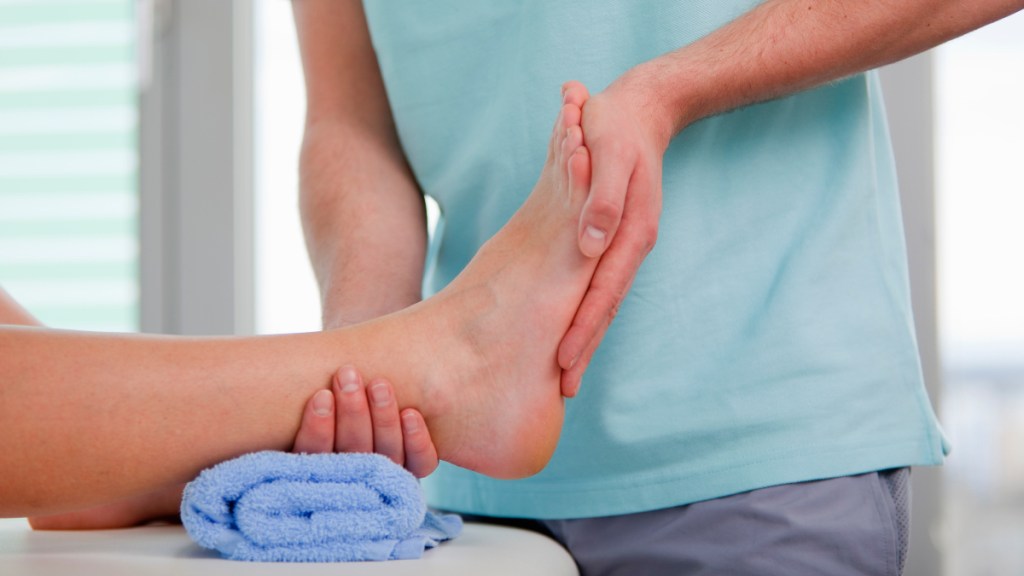Is Your Plantar Fasciitis Pain So Bad You Can’t Walk? Podiatrists Reveal Why You Likely *Don’t* Need Surgery
Doctors share their top 4 home remedies you should try before going under the knife

You’ve been busy lately (who hasn’t?), running errands and dashing from one activity to the next. But if this uptick in activity has triggered a sharp, shooting pain in your heel, it could a sign of plantar fasciitis. This common, painful condition impacts your foot and heel, and is especially bothersome after sleeping. For some people, though, the pain worsens over time and becomes severe, leaving you wondering Why do I have plantar fasciitis so bad I can’t walk? Here, we’ll explore the causes and best solutions to ease even the most intense pain.
Understanding plantar fasciitis
Plantar fasciitis accounts for upwards of one million doctor visits annually. And to get a better understanding of it, it’s important to first know what the plantar fascia actually is. Picture your foot: There’s a fibrous band that extends from your heel into the ball of your foot, providing shock absorption and arch support. Pain, especially in or around your heel, can happen if this band gets inflamed.
It’s an overuse syndrome, explains Lori Barnett, DPM, a podiatrist with Lehigh Valley Physicians Group based in Allentown, PA. “Most of the time, I find that people are doing the dot-and-dash workout schedule,” she says. “So they’ll walk for a long period of time, and they’re doing well, and then they have to stop for a while for whatever reason. And then they go back at the same level with maybe the older pair of shoes or they just aren’t conditioned.” While you might not notice pain right away, with continued overuse and pounding on the heel, it can show up, she says.

More common causes of plantar fasciitis
Garrett Nguyen, DPM, a fellowship-trained reconstructive foot and ankle surgeon at the Paley Orthopedic & Spine Institute – Foot and Ankle Center at St. Mary’s Hospital in West Palm Beach, FL, adds that it’s typically associated with a change in activity, trauma or improper shoe gear. He often sees the condition show up in “weekend warriors”, people who have increased their activity, or those in training for an event, but who haven’t done that type of activity in recent years. “That usually spurs or incites that kind of inflammation and pain,” he notes.
Other factors are also at play, such as walking with poor biomechanics, due to, for instance, flat feet, says Dr. Barnett. (Not everyone with flat feet will get plantar fasciitis, she notes.) “The other thing that happens is that the heel has a fat pat underneath it. Over time, with weight, with repetitive motion, that fat pad spreads and it flattens,” she explains. That means you need even more support in that heel area as you age to sidestep pain.
Plantar fasciitis so bad I can’t walk: Severe pain
While plantar fasciitis can impact anyone, it’s common among middle-aged adults. The good news: Our experts estimate that for about 80-90% of folks, plantar fasciitis will resolve with more conservative treatments. That means things like stretching or changing your shoes for better support.
It could also include things like physical therapy, steroid injections or even shockwave therapy, where light waves are pulsed into the heel to ease inflammation. In one study of people who had shockwave therapy, they all saw a reduction in pain and increase in quality of life as far as 12 weeks out.

Still, some people do end up with more severe plantar fasciitis pain that’s so bad they can’t walk. This could simply be because they didn’t see the signs, explains Dr. Barnett. “I have people who come with a year of heel pain that just thought it was an aging thing, and it’s obviously so much more than that,” she says.
Meanwhile, there are others who follow all the conservative treatment methods to the letter only to find they’re also dealing with additional issues, such as an abnormal tearing of the plantar fascia band, says Dr. Nguyen. (Imaging, like an MRI, can help pinpoint that.) On the flip side, some people get severe pain because it’s tough to keep up with the treatments. As Dr. Nguyen notes, “They haven’t quite stuck it out, or it gets better for maybe a day or two and then they kind of abandon the treatment options.” (Click through to see how one woman used flip flops to ease plantar fasciitis pain.)
Two types of plantar fasciitis surgery
So, if your plantar fasciitis pain is so bad you can’t walk, should you consider surgery? Unless you come in with a pretty severe case, podiatrists or foot and ankle surgeons — that’s the kind of doctor who can both treat and perform surgery for plantar fasciitis — will run usually through all the less invasive options first.
As Dr. Nguyen explains, they want to “go through plan A, B, C, and D before we go to Z, the surgical treatment option. But it’s a really small majority of patients that don’t get relief with the conservative treatment options that we have to talk about surgery.”
For those who do require surgery, two common procedures are:
Instep plantar fasciotomy
Dr. Barnett explains that, with this procedure, a small incision is made on the bottom of the foot . The doctor will clip a small portion of the plantar fascia to release it and ease pain. It’s an outpatient procedure, so there’s no overnight stay in the hospital. And it’s quick, anywhere from 10 to 15 minutes, Dr. Barnett says.
“That’s my go-to and I’ve had good results with it,” she explains. Research suggests that the success rate is high, with one study putting it at over 90%. The most common complication, according to the study authors, was scarring.
Endoscopic plantar fasciotomy (EPF)
“With this minimally invasive procedure, a tiny incision is made on the inside of the heel. Using a small camera to visualize the plantar fascia band, part of the ligament is released, relieving abnormal tension caused by plantar fasciitis. This ultimately decreases the inflammation and pain in the heel, allowing patients to return to their activities of daily living faster with minimal to no complications,” explains Dr. Nguyen.
This is also a quick outpatient procedure, and the success rate can be as high as 90%, research suggests. As Dr. Nguyen notes, it’s “extremely successful, with minimal to low complications, small incisions and low downtime.”
With both procedures, you’ll have to ice and elevate your foot afterwards, and you may also be told you can’t drive for a short period of time. A boot is worn post-op. With the EPF procedure, Dr. Nguyen notes that you can walk and bear weight on it immediately. Doctors advise only necessary movement, like walking to the bathroom, for those first three days. Expect to wear the boot for a few weeks after surgery with either procedure.
Home remedies that ease plantar fasciitis pain
Whether you’re waiting to have surgery or decided to try conservative treatments first, there are easy home remedies that can help ease plantar fasciitis pain so you walk with less discomfort. These tactics can be helpful for plantar fasciitis pain across the board, from mild to more chronic pain.
1. Try the water bottle trick
This simple trick goes a long way toward easing inflammation. Dr. Nguyen recommends using an ice pack for the first 4 to 6 weeks after your initial injury. Once that period is over, try rolling your foot and heel over over a frozen water bottle. Not only does it help with inflammation, but it also gently stretches the plantar fascia to prevent recurrence, Dr. Nguyen says. “While rolling and applying gentle pressure, patients can hold a water bottle at specific points where they feel pain. Patients can perform this routine 3 to 5 times a day for no more than 10 to 20 minutes to prevent soft tissue injury from the cold,” he explains.

2. Do a towel stretch
“Stretching out your foot really helps to relieve the pain,” Dr. Barnett says. In addition to the water bottle stretch above, you can use a simple towel to help loosen up the plantar fascia muscle. Dr. Barnett recommends placing a towel under the ball of your foot and gently pulling your forefoot towards you. (You can keep a slight bend in your knee.) Hold for 20 seconds, then release. Repeat five times. “The stretch will be felt in the calf and possibly the heel or arch area,” she says. She advises doing this three times a day, especially before getting out of bed in the morning. For a visual guide, check out the short video below.
3. Opt for anti-inflammatories
Dr. Nguyen stresses the importance of reducing pain-causing inflammation when you have plantar fasciitis. You can take over-the-counter anti-inflammatory medications, like Motrin or Aleve, or prescription options such as Celecoxib, which can be easier on the stomach, he says. (With the OTC options, touch base with your doctor on frequency and duration.)
Another option: An anti-inflammatory gel, which can be used on the bottom of your foot. “It really can help reduce the pain, and massaging it in really helps with that,” says Dr. Barnett, who recommends talking to your doctor before using any craems or gels. A few she likes:
- Aspercreme With Lidocaine Foot Cream (Buy from Amazon, $9.98)
- MagniLife DB Pain Relieving Foot Cream (Buy from Amazon, $15.12)
- MediNatura Traumeel Analgesic Ointment (Buy from Amazon, $26.99)
- Arnica, such as Boiron Arnicare Gel (Buy from Amazon, $8.54)
- Diclofenac gel, such as Voltaren Arthritis Pain Gel (Buy from Amazon, $18.48)
For more movements that can help ease your pain, take a look at the video class Exercises and Stretches for Pain-Free Walking.
4. Swap your shoes
As Dr. Barnett explains, “if you break your foot, we put you in a cast. For plantar fasciitis, we put you in a good shoe.” Dr. Nguyen agrees, noting that proper shoes and orthotics provide that much-needed support so as not to make plantar fasciitis worse — and to prevent future flare ups so you can walk without pain.
“Footwear with a thick midsole or rocker bottom is ideal for plantar fasciitis,” Dr. Nguyen says. “And shoes with firm heel support will also minimize stretching of the plantar fasciitis and help ease pain.”
Dr. Nguyen also recommends replacing shoes every 8 to 12 months; for running shoes, it’s about every 300 to 450 miles. Otherwise, you may end up with uneven wear patterns or loss of support, he notes. To find the best fit, talk to your podiatrist or visit a running store, ideally one with a foot/ankle specialist on staff. (Click through to see doctor’s best insoles for plantar fasciitis.)
For more ways to ease foot pain:
Massage Pros Share Their Easy Moves for Your Best-Ever DIY Foot Rub + 6 Ways It Boosts Health, Too
Top of Foot Pain Is The Foot Problem No One Talks About — Doctors Reveal How to Outsmart It
This content is not a substitute for professional medical advice or diagnosis. Always consult your physician before pursuing any treatment plan.













